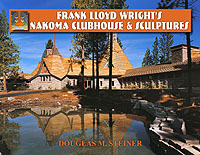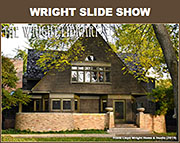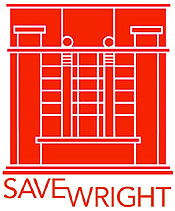|
|
|
Isidore
Heller Residence, Chicago, Illinois (1896 - S.038) |
|
|
|
1964 HAROLD
ALLEN 1965 RICHARD NICKEL
|
|
|
Drawings By J. Rex Poggenpohl,
1964
Exterior
Photographs By Harold
Allen, June 15, 1964 |
|
|
The Isidore Heller House was
designed by Frank Lloyd Wright for a narrow city lot in the
Hyde Park district of Chicago. It belongs to a stylistic
category of Wright’s work that has been termed 'Monitor'
referring to the third story which is raised above the main
eaves and capped by a smaller hip roof. The arcade and
frieze of this story contains elaborate Sullivanesque
ornament and sculptural figures, the latter executed by
Richard Bock.
The Living, Dining, and Reception Rooms as
well as the Kitchen are on the first floor. Five bedrooms
are on the second floor. Playroom is on the third floor. The
large brick tower houses an elevator that services the
basement and all three floors. The elevator tower and back
entrance were not part of the original drawings published in
1900, and both may have been added when Wright added the
elevator in 1909. The The Roman brick on the first floor is
buff, the second and third floors, above the |
|
horizontal stone trim alternates buff and gray bricks. The
Living Room windows are bordered with horizontal stone. The
square panels below the Living Room windows match the billet
molding framing the main entrance.
The North (back) entrance sets on a
thick limestone foundation, very similar to the foundation of
the
Husser Residence (1899). The art glass windows, different
than those of the stairway, repeats the design element in the
upper Sullivanesque panels, seen between the winged maidens.
The large limestone columns on either side
of the entrance are octagonal in shape, with ornamental
Sullivanesque capitals. The columns support three square
frieze panels, each with a quatrefoil design. The light fixture
has been replaced with one more consistent with the design
of the home. The entrance is framed with a billet molding. |
|
|
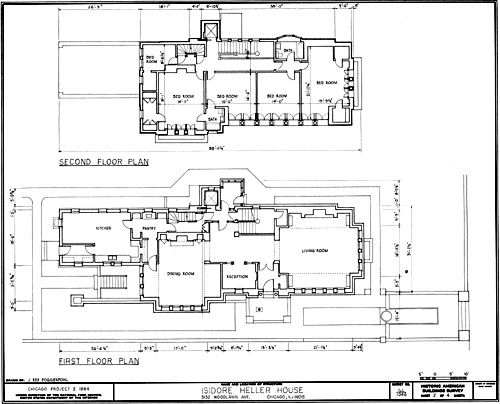 |
|
HABS 1: Isidore Heller Residence,
HABS Measured Drawings, First and Second Floor Plan, 1964 (1896
- S.038). "The Isidore Heller House was designed by Frank Lloyd
Wright for a narrow city lot in the Hyde Park district of
Chicago. It belongs to a stylistic category of Wright’s work
that has been termed ‘Monitor’ referring to the third story
which is raised above the main eaves and capped by a smaller hip
roof. The arcade and frieze of this story contains elaborate
Sullivanesque ornament and sculptural figures, the latter
executed by Richard Bock... Recorded by the National Park
Service... Measured and drawn during the summer of 1964 under
the direction of James C. Massey. Drawn by: J Rex Poggenpohl."
Historic American Building Survey, Courtesy of the Library of
Congress.
|
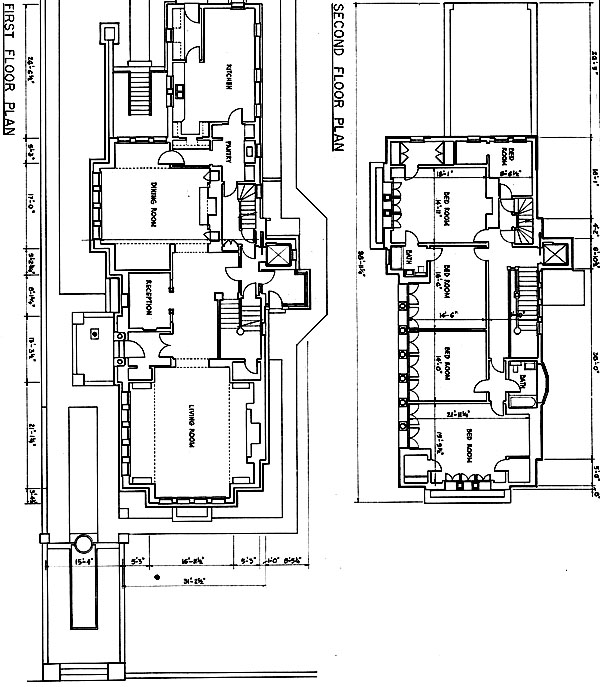 |
|
|
|
|
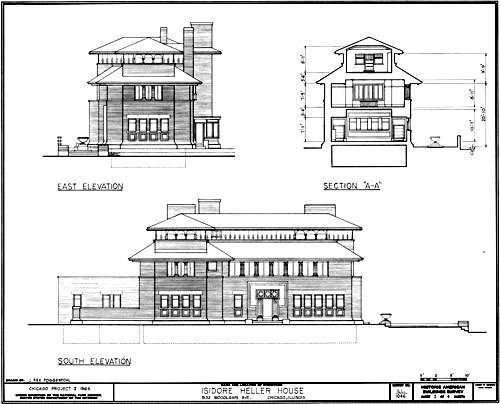 |
|
HABS 2: Isidore Heller
Residence, HABS Measured Drawings, South and East
Elevations, 1964 (1896 - S.038). "The Isidore Heller House
was designed by Frank Lloyd Wright for a narrow city lot in
the Hyde Park district of Chicago. It belongs to a stylistic
category of Wright’s work that has been termed ‘Monitor’
referring to the third story which is raised above the main
eaves and capped by a smaller hip roof. The arcade and
frieze of this story contains elaborate Sullivanesque
ornament and sculptural figures, the latter executed by
Richard Bock... Recorded by the National Park Service...
Measured and drawn during the summer of 1964 under the
direction of James C. Massey. Drawn by: J Rex Poggenpohl."
Historic American Building Survey, Courtesy of the Library
of Congress. |
|
|
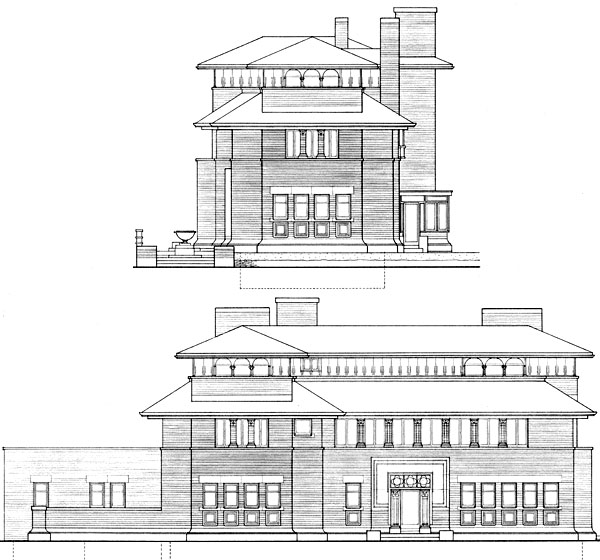 |
|
HABS 2A: East
Elevations (upper) and South Elevation (lower). |
|
|
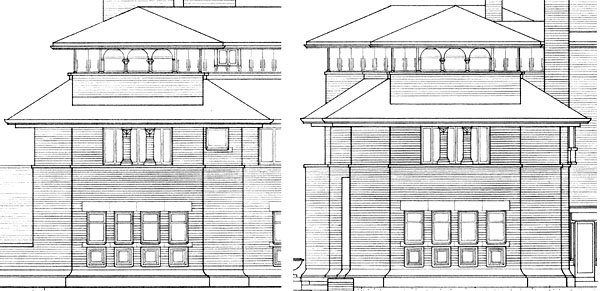 |
|
HABS 2B: Comparison of the
Dining Room, South Elevation (left) and Living Room. East
Elevations (right), Wright repeats the design on the
exterior of the Dining and Living Rooms. |
|
|
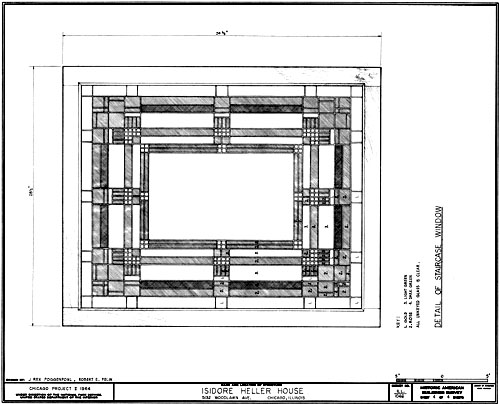 |
HABS 3: Isidore Heller
Residence, HABS Measured Drawings, Detail of Staircase
Window, 1964 (1896 - S.038). "The Isidore Heller House was
designed by Frank Lloyd Wright for a narrow city lot in the
Hyde Park district of Chicago. It belongs to a stylistic
category of Wright’s work that has been termed ‘Monitor’
referring to the third story which is raised above the main
eaves and capped by a smaller hip roof. The arcade and
frieze of this story contains elaborate Sullivanesque
ornament and sculptural figures, the latter executed by
Richard Bock... Recorded by the National Park Service...
Measured and drawn during the summer of 1964 under the
direction of James C. Massey. Drawn by: J Rex Poggenpohl."
Historic American Building Survey, Courtesy of the Library
of Congress.
|
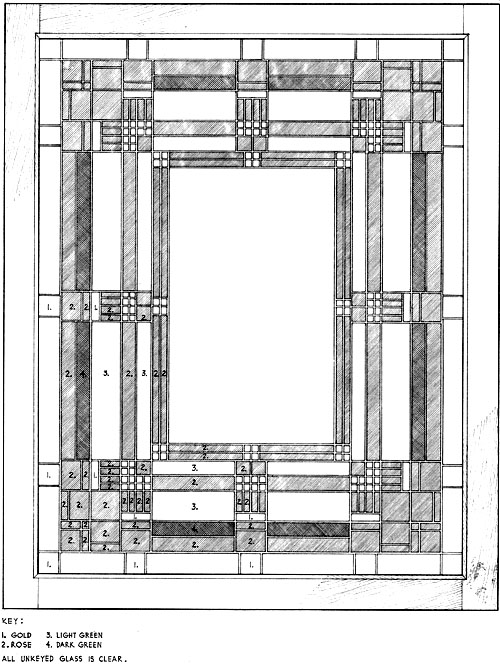 |
|
|
|
|
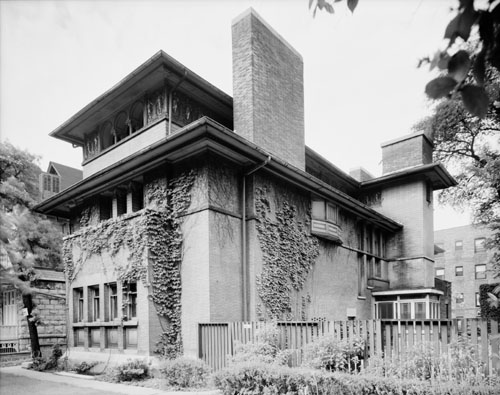 |
|
1: Isidore Heller
Residence, Chicago, Street view,1964 (1896 - S.038). Viewed from the
Northeast. Ivy has begun to grow again. A wooden fence has
been added to the right side. The Living Room is on the
first floor, the side entrance on the North side can be seen
on the far right. Five bedrooms are on the second floor. The
east bedroom windows open to a ledge. The windows just to the
right of the chimney is one of two bathrooms on the second
floor. The large brick tower just behind the side entrance,
houses an elevator that services the basement and all three
floors. The elevator tower and back entrance were not part
of the original drawings published in 1900, and both may
have been added when Wright added the elevator in 1909. The Playroom is on the third floor. The Roman brick
on the first floor is buff, the second and third floors,
above the horizontal stone trim alternates buff and gray
bricks. The Living Room windows are bordered with horizontal
stone. The square panels below the Living Room windows match
the billet molding framing the main entrance. Photographed
by Harold Allen on June 15, 1964. Courtesy of the Library of
Congress. |
|
|
|
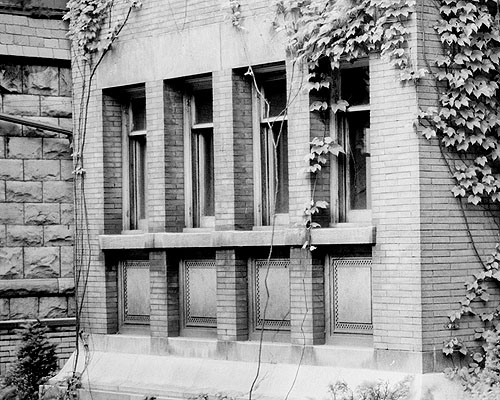 |
|
1A:
Isidore Heller
Residence, Chicago, Living Room window detail,1964 (1896 - S.038). Viewed
from the Northeast. Ivy has begun to grow again. The Living
Room is on the first floor. The Roman brick on the first
floor is buff. The Living Room windows are bordered with
horizontal stone. The square panels below the Living Room
windows match the billet molding framing the main entrance.
Photographed by Harold Allen on June 15, 1964. Courtesy of
the Library of Congress. |
|
|
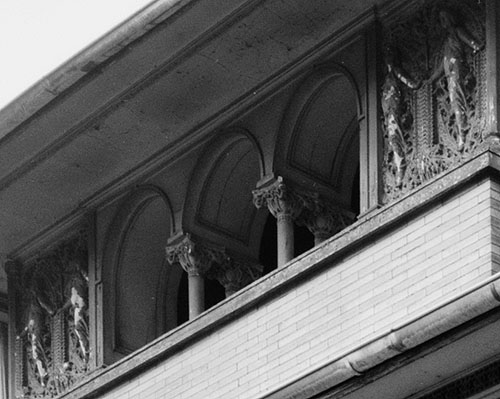 |
|
1B:
Isidore Heller
Residence, Chicago, Detail of the third floor,1964 (1896 - S.038). Viewed
from the Northeast. Three arches are set between plaster
Sullivanesque panels with high relief winged maidens. Pairs
of colonettes are topped with
large, spreading ornamental Sullivanesque plaster capitals. Both the plaster
maidens and capitals show deterioration. The Roman brick on the second and
third floors alternates buff and gray bricks. Photographed by Harold Allen
on June 15, 1964. Courtesy of the Library of Congress. |
|
Cap3 |
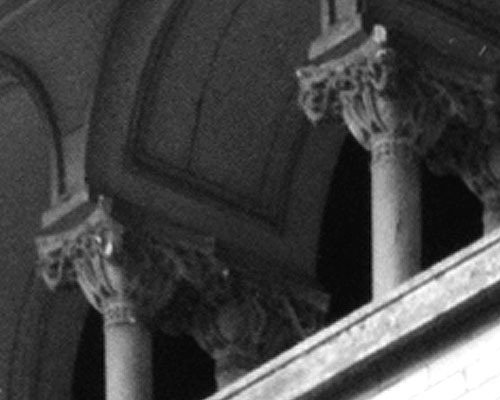 |
|
1C:
Isidore Heller
Residence, Chicago, Detail of the third floor capitals,1964 (1896 - S.038).
Viewed from the Northeast. Pairs of colonettes are topped with large,
spreading ornamental Sullivanesque plaster capitals. Plaster capitals show
deterioration. Photographed by Harold Allen on June 15, 1964. Courtesy of
the Library of Congress. |
|
|
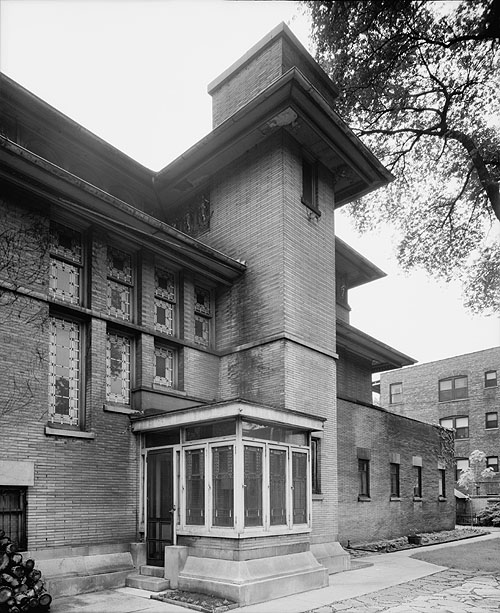 |
|
2: Isidore Heller Residence,
Chicago, North side,1964 (1896 - S.038). Viewed from the
Northeast. Remnants of ivy can be seen at the top left. The art
glass windows follow the stairs that lead to the second floor.
The window sills are limestone, as is the horizontal trim that
runs the length of the home. The North (back) entrance sets on a
thick limestone foundation, very similar to the foundation of
the
Husser Residence (1899). The art glass windows, different
than those of the stairway, repeats the design element in the
upper Sullivanesque panels, seen between the winged maidens. The
large brick tower just behind the side entrance, houses an
elevator that services the basement and all three floors.
The elevator tower and back
entrance were not part of the original drawings published in
1909, and both may have been added when Wright added the
elevator in 1909. The
Pantry and Kitchen are just beyond the that. Five bedrooms are
on the second floor. Photographed by Harold Allen on June 15,
1964. Courtesy of the Library of Congress. |
|
|
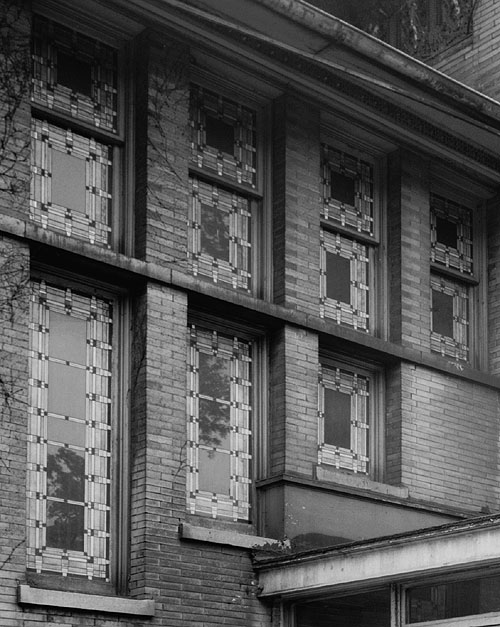 |
|
2A: Isidore Heller Residence,
Chicago, Detail of the North side windows,1964 (1896 - S.038).
Viewed from the Northeast. The art glass windows follow the
stairs that lead to the second floor. The window sills are
limestone, as is the horizontal trim that runs the length of the
home. Photographed by Harold Allen on June 15, 1964. Courtesy of
the Library of Congress. |
|
|
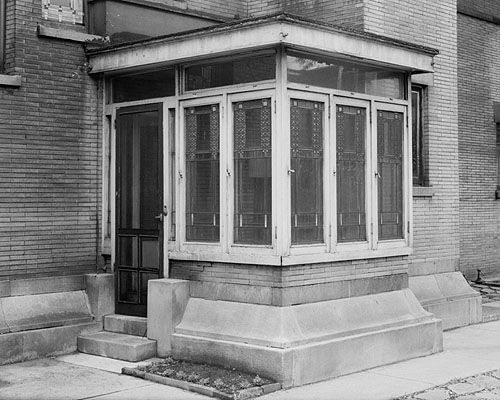 |
|
2B: Isidore Heller Residence,
Chicago, Detail of the North side back entrance,1964 (1896 -
S.038). Viewed from the Northeast. The North (back) entrance
sets on a thick limestone foundation, very similar to the
foundation of the
Husser Residence (1899).
The elevator tower and back
entrance were not part of the original drawings published in
1900, and both may have been added when Wright added the
elevator in 1909. The art glass
windows, different than those of the stairway, repeats the
design element in the upper Sullivanesque panels, seen between
the winged maidens. Photographed by Harold Allen on June 15,
1964. Courtesy of the Library of Congress. |
|
|
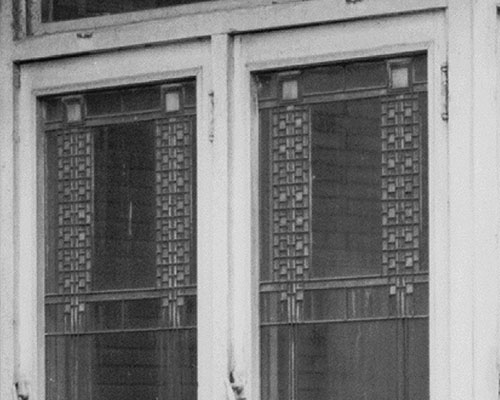 |
|
2C: Isidore Heller Residence,
Chicago, Detail of the North side back entrance art glass ,1964
(1896 - S.038). Viewed from the Northeast. The art glass
windows, different than those of the stairway, repeats the
design element in the upper Sullivanesque panels, seen between
the winged maidens. Photographed by Harold Allen on June 15,
1964. Courtesy of the Library of Congress. |
|
|
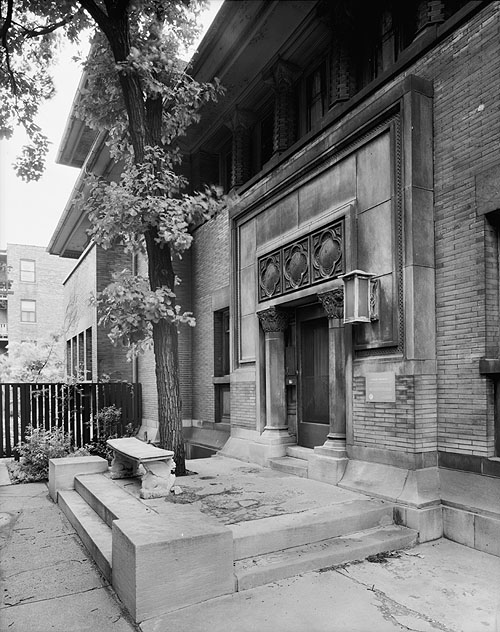 |
|
3: Isidore Heller Residence
Entrance, Chicago, 1964 (1896 - S.038). View from the Southeast.
The large limestone columns on either side of the entrance are
octagonal in shape, with ornamental Sullivanesque capitals. The
columns support three square frieze panels, each with a quatrefoil
design. The light fixture has been replaced with one more
consistent with the design of the home. The entrance is framed
with a billet molding. The Dining Room is seen on the far left.
The Lining Room is to the right of the Entrance. Five bedrooms
are on the second floor. Photographed by Harold Allen on June
15, 1964. Courtesy of the Library of Congress. |
|
|
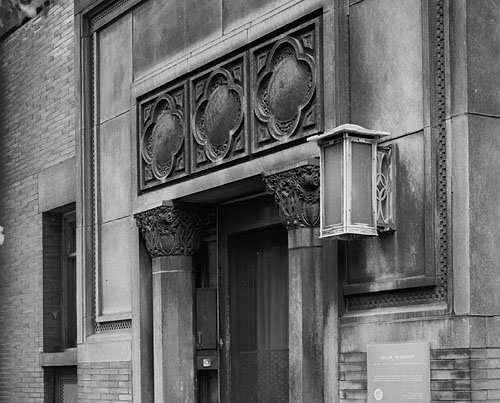 |
|
3A: Isidore Heller Residence
Entrance detail, Chicago, 1964 (1896 - S.038). View from the
Southeast. The large limestone columns on either side of the
entrance are octagonal in shape, with ornamental Sullivanesque
capitals. The columns support three square frieze panels, each with a
quatrefoil design. The light fixture has been replaced with one
more consistent with the design of the home. The entrance is
framed with a billet molding. Photographed by Harold Allen on
June 15, 1964. Courtesy of the Library of Congress. |
|
|
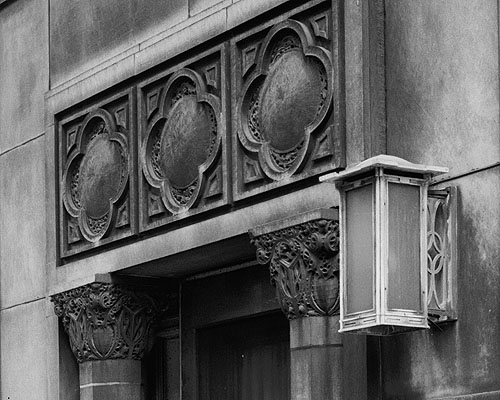 |
|
3B: Isidore Heller Residence
Entrance detail, Chicago, 1964 (1896 - S.038). View from the
Southeast. The large limestone columns on either side of the
entrance are octagonal in shape, with ornamental Sullivanesque
capitals. The columns support three square frieze panels, each with a
quatrefoil design. The light fixture has been replaced with one
more consistent with the design of the home. Photographed by
Harold Allen on June 15, 1964. Courtesy of the Library of
Congress. |
|
Cap1 |
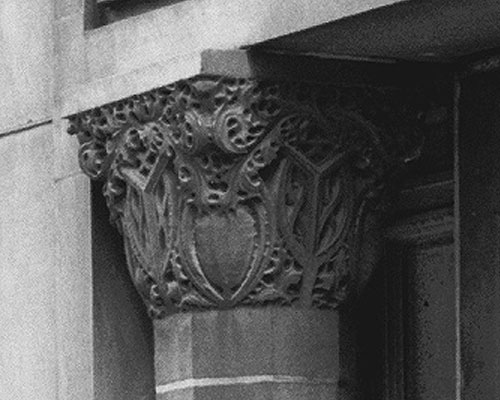 |
|
3C: Isidore Heller Residence
Entrance detail, Chicago, 1964 (1896 - S.038). View from the
Southeast. The large limestone columns are octagonal in shape,
with ornamental Sullivanesque capitals. Photographed by Harold
Allen on June 15, 1964. Courtesy of the Library of Congress.
|
|
|
|
|
|
|
|
|
|
Exterior
and Interior
Photographs By Richard
Nickel, 1965 |
|
|
Under copper gutters are
decorative plaster soffits. Plaster panels include high
relief winged maidens, set within a low relief Sullivanesque
design. Relief is showing extreme deterioration. Corners are
trimmed with a large based octagonal column.
The front door leads into the entry
vestibule. It originally opened up into the reception hall,
which has been blocked by a built-in bookcase. A set of
doors open inward and lead to the main hall. Oak woodwork
frames the ceiling and wall spaces. Walls are trimmed with
large oak baseboards. A stairway in the reception hall leads
to the second level. A large square newel post is
decorated at the top with a Sullivanesque filigree trim.
Tightly packed spindles form screens, partially hiding the
stairway. Opposite the stairway is the reception room.
Octagonal oak columns set atop square oak pedestals, both
decorated at the top with matching Sullivanesque filigree
trim.
One of Wright’s hallmark’s was to vary
ceiling heights. Raising it in some areas, lowering it in
other areas in the same room. Creating a room within a room.
This creates the illusion that the ceiling is higher than it
actually is. Wright described the living room in the June
1900 issue of Architectural Review, "Interior walls |
|
of
rough sand finish. Trimmed in quartered and waxed white oak.
Plaster saturated with pure color. Floor finish and
furniture of one wood and color throughout. Lighting
fixtures in main rooms wooden standards with globes worked
in brass and opalescent glass. Interior color scheme bronze
and dull green." The living room brick fireplace is framed
in oak. Built-in bookcases balance each side of the
fireplace area. The fireplace and bookcase ends are faced
with delicate filigree panels. The Living Room’s brass light
standards were removed, but outlines of the standard’s bases
remain on the floor in the living room.
Oak woodwork frames the stairway, ceiling
and wall spaces. Although the newel post on the first floor
was square, this newel post on the landing between the first
and second floors is octagonal in shape and matches the
upper column in the reception room, and is decorated at the
top with the Sullivanesque filigree trim. Three upper posts
are square and without the filigree trim. Tightly packed
spindles form screens, partially hiding the stairway from
the reception hall. Eleven art glass windows follow the
stairs that lead to the second floor. |
| |
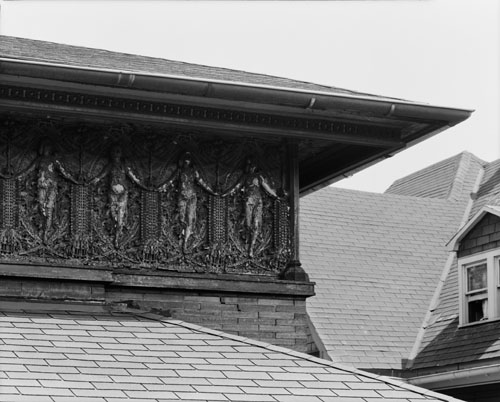 |
| 4: Isidore
Heller Residence, Chicago, view of third floor frieze, 1965
(1896 - S.038). Detail of the plaster frieze of the
Southeast corner of the third floor. Viewed from the South.
Under the copper gutters are decorative plaster soffits.
Plaster panels include high relief winged maidens, set
within a low relief Sullivanesque design. Relief is showing
extreme deterioration. Corners are trimmed with a large
based octagonal column. The Roman brick on the second and
third floors alternates buff and gray bricks. Photographed
by Richard Nickel in 1965. Courtesy of the Library of
Congress. |
| |
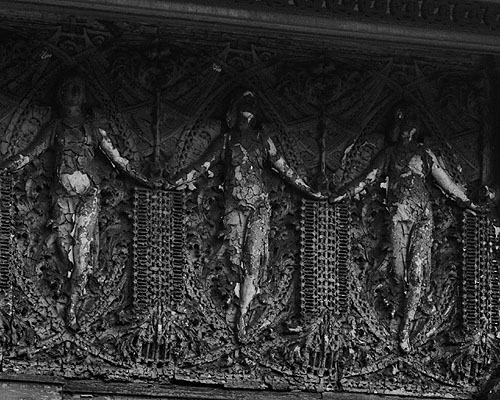 |
| 4A:
Isidore Heller Residence, Chicago, detail of third floor
frieze, 1965 (1896 - S.038). Detail of the plaster frieze of
the Southeast corner of the third floor. Viewed from the
South. Plaster panels include high relief winged maidens,
set within a low relief Sullivanesque design. The design
element between the maidens is similar to the art glass in
the back entrance to the home, and elements in the title
page for "The Eve of St. Agnes", designed by Wright and
published in 1896, and "House Beautiful", designed by Wright
and published in 1897. Relief is showing extreme
deterioration. Photographed by Richard Nickel in 1965.
Courtesy of the Library of Congress. |
| |
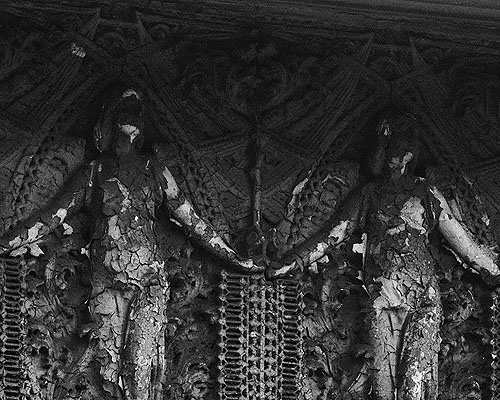 |
| 4B:
Isidore Heller Residence, Chicago, detail of third floor
frieze, 1965 (1896 - S.038). Detail of the plaster frieze of
the Southeast corner of the third floor. Viewed from the
South. Plaster panels include high relief winged maidens,
set within a low relief Sullivanesque design. The design
element between the maidens is similar to the art glass in
the back entrance to the home, and elements in the title
page for "The Eve of St. Agnes", designed by Wright and
published in 1896, and "House Beautiful", designed by Wright
and published in 1897. Relief is showing extreme
deterioration. Photographed by Richard Nickel in 1965.
Courtesy of the Library of Congress. |
| |
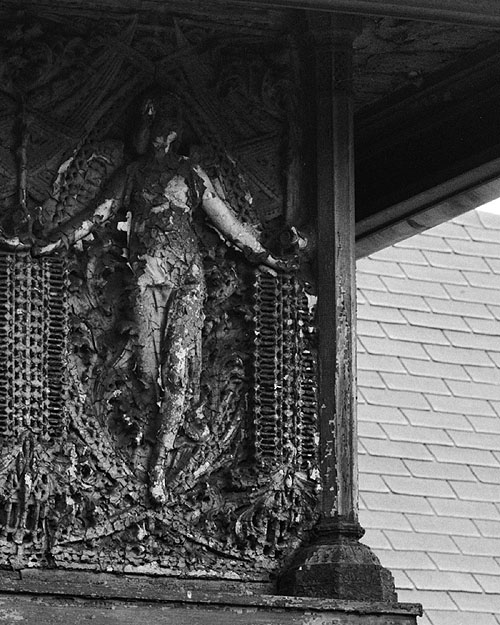 |
| 4C:
Isidore Heller Residence, Chicago, detail of third floor
frieze, 1965 (1896 - S.038). Detail of the plaster frieze of
the Southeast corner of the third floor. Viewed from the
South. Relief is showing extreme deterioration. Corners are
trimmed with a large based octagonal column. Photographed by
Richard Nickel in 1965. Courtesy of the Library of Congress.
|
| |
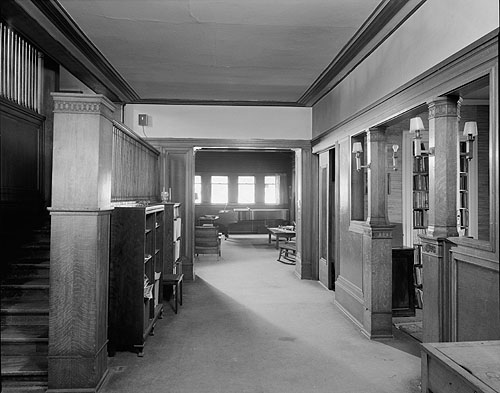 |
| 5:
Isidore Heller Residence Hall, Chicago, 1965 (1896 - S.038).
Viewed from the West, looking toward the Living Room. The
front door leads into the entry vestibule. It originally
opened up into the reception hall, which has been blocked by
a built-in bookcase. A set of doors open inward and lead to
the main hall. Oak woodwork frames the ceiling and wall
spaces. Walls are trimmed with large oak baseboards. The
stairway on the left leads to the second level. The large
square newel post is decorated at the top with a
Sullivanesque filigree trim. Tightly packed spindles form
screens, partially hiding the stairway. Opposite the
stairway is the reception room. Octagonal oak columns set
atop square oak pedestals, both decorated at the top with
matching Sullivanesque filigree trim. Photographed by
Richard Nickel in 1965. Courtesy of the Library of Congress. |
| |
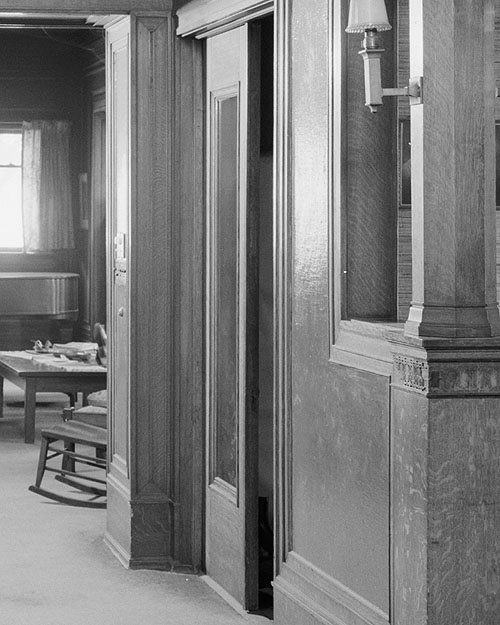 |
| 5A:
Isidore Heller Residence Hall, Details of vestibule doors,
Chicago, 1965 (1896 - S.038). The front door leads into the
entry vestibule. A set of doors open inward and lead to the
main hall. Oak woodwork frames the ceiling and wall spaces.
Walls are trimmed with large oak baseboards. Photographed by
Richard Nickel in 1965. Courtesy of the Library of Congress. |
| |
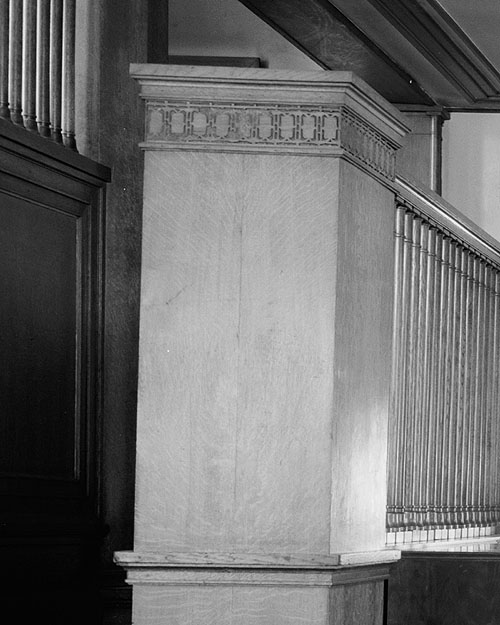 |
| 5B:
Heller Residence Hall, Detail of stairway, Chicago, 1965
(1896 - S.038). Oak woodwork frames the ceiling and wall
spaces. Walls are trimmed with large oak baseboards. The
stairway leads to the second level. The large square newel
post is decorated at the top with a Sullivanesque filigree
trim. Tightly packed spindles form screens, partially hiding
the stairway. Photographed by Richard Nickel in 1965.
Courtesy of the Library of Congress.
|
| |
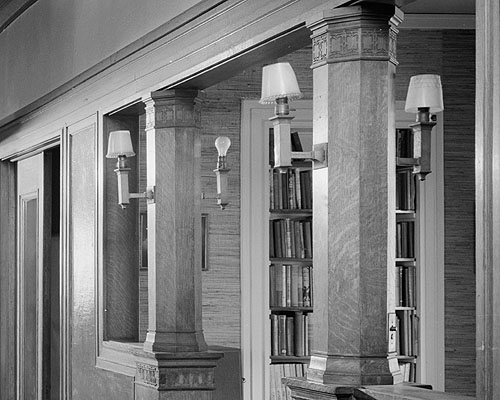 |
| 5C:
Isidore Heller Residence Hall, Detail of Reception Room
entrance, Chicago, 1965 (1896 - S.038). The front door leads
into the entry vestibule. It originally opened up into the
reception hall, which has been blocked by a built-in
bookcase. A set of doors open inward and lead to the main
hall. Oak woodwork frames the ceiling and wall spaces. Walls
are trimmed with large oak baseboards. Octagonal oak columns
set atop square oak pedestals, both decorated at the top
with matching Sullivanesque filigree trim. Photographed by
Richard Nickel in 1965. Courtesy of the Library of Congress. |
| |
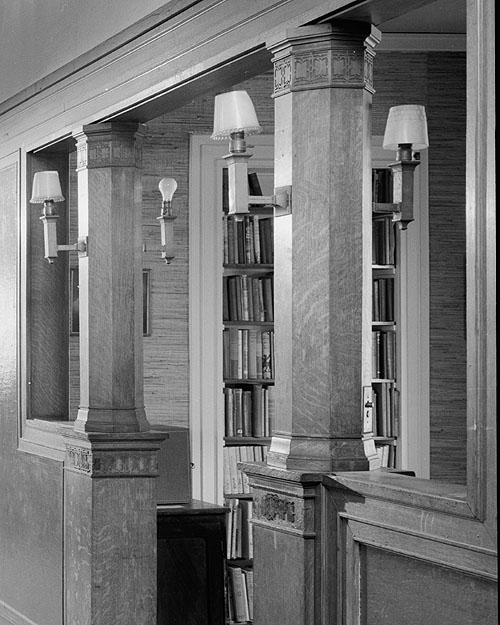 |
| 5D:
Isidore Heller Residence Hall, Detail of Reception Room
entrance, Chicago, 1965 (1896 - S.038). The entry vestibule
originally opened up into the reception hall, which has been
blocked by a built-in bookcase. Octagonal oak columns set
atop square oak pedestals, both decorated at the top with
matching Sullivanesque filigree trim. Photographed by
Richard Nickel in 1965. Courtesy of the Library of Congress. |
|
CapH |
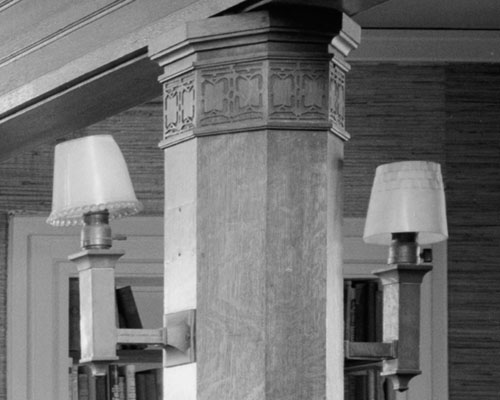 |
| 5E:
Isidore Heller Residence Hall, Detail of Reception Room
column, Chicago, 1965 (1896 - S.038). Octagonal oak columns
set atop square oak pedestals, both decorated at the top
with matching Sullivanesque filigree trim. Photographed by
Richard Nickel in 1965. Courtesy of the Library of Congress. |
| |
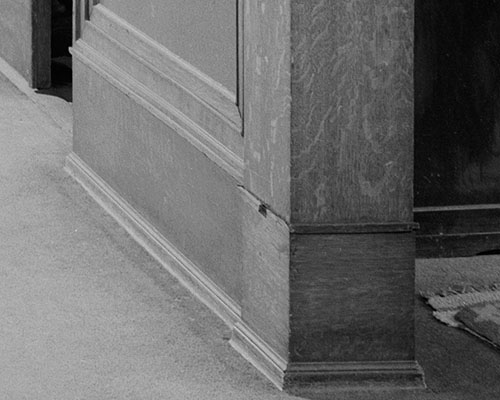 |
| 5F:
Isidore Heller Residence Hall, Baseboard detail, Chicago,
1965 (1896 - S.038). Walls are trimmed with large oak
baseboards. Photographed by Richard Nickel in 1965. Courtesy
of the Library of Congress.
|
| |
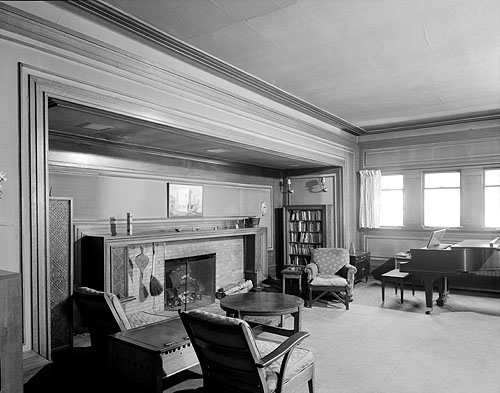 |
| 6: Isidore
Heller Residence Living Room, Chicago, 1965 (1896 - S.038).
Viewed from the Southwest. One of Wright’s hallmark’s was to
vary ceiling heights. Raising it in some areas, lowering it
in other areas in the same room. Creating a room within a
room. This creates the illusion that the ceiling is higher
than it actually is. Wright described the room in the June
1900 issue of Architectural Review, "Interior walls of rough
sand finish. Trimmed in quartered and waxed white oak.
Plaster saturated with pure color. Floor finish and
furniture of one wood and color throughout. Lighting
fixtures in main rooms wooden standards with globes worked
in brass and opalescent glass. Interior color scheme bronze
and dull green." The living room brick fireplace is framed
in oak. Built-in bookcases balance each side of the
fireplace area. The fireplace and bookcase ends are faced
with delicate filigree panels. The Living Room’s brass light
standards were removed, but outlines of the standard’s bases
remain on the floor in the living room. Photographed by
Richard Nickel in 1965. Courtesy of the Library of Congress.
|
| |
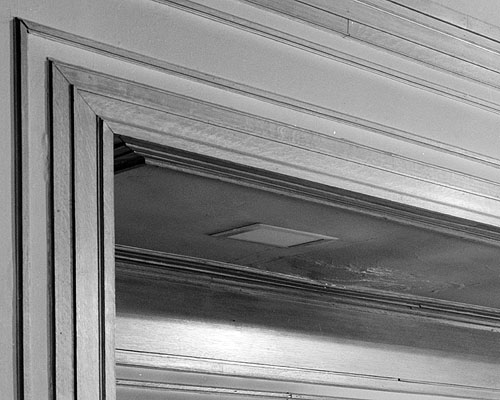 |
| 6A:
Isidore Heller Residence Living Room, Detail of fireplace
trim, Chicago, 1965 (1896 - S.038). Wright described the
room in the June 1900 issue of Architectural Review,
"Interior walls of rough sand finish. Trimmed in quartered
and waxed white oak. Plaster saturated with pure color.
Floor finish and furniture of one wood and color throughout.
Lighting fixtures in main rooms wooden standards with globes
worked in brass and opalescent glass. Interior color scheme
bronze and dull green." The living room brick fireplace is
framed in oak. Photographed by Richard Nickel in 1965.
Courtesy of the Library of Congress. |
| |
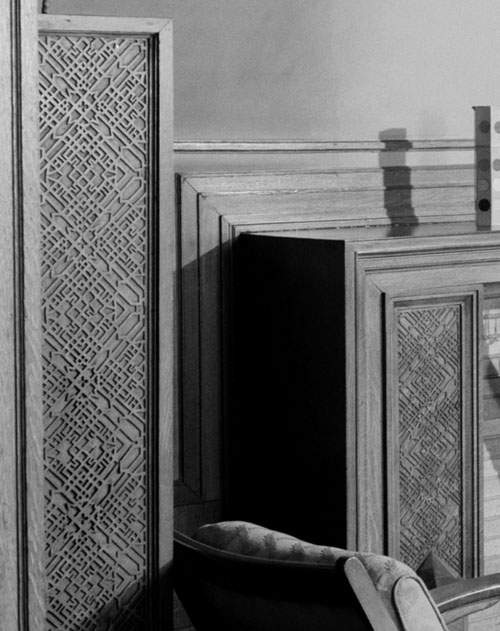 |
| 6B:
Isidore Heller Residence Living Room, Detail of the filigree
panels, Chicago, 1965 (1896 - S.038). The living room brick
fireplace is framed in oak. Built-in bookcases balance each
side of the fireplace area. The fireplace and bookcase ends
are faced with delicate filigree panels. The filigree panel
on the left is on the side of the bookcase, the filigree
panel on the right is built into the fireplace trim.
Photographed by Richard Nickel in 1965. Courtesy of the
Library of Congress. |
| |
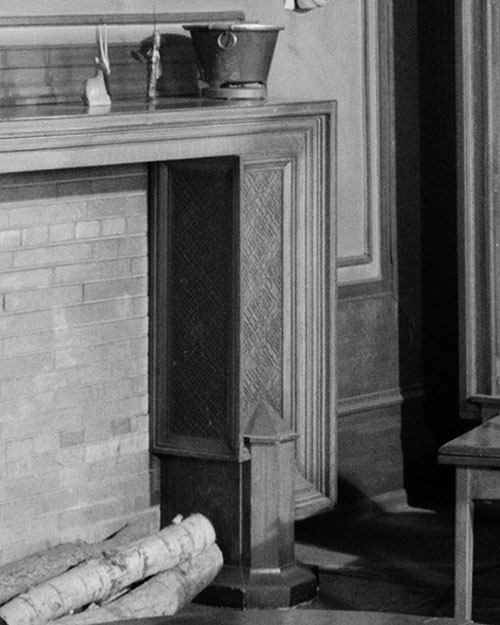 |
| 6C:
Isidore Heller Residence Living Room, Fireplace detail.
Chicago, 1965 (1896 - S.038). The living room brick
fireplace is framed in oak. The fireplace ends are faced
with delicate filigree panels on the inside and front. At
the base of the front panel is a short built-in octagonal
column, repeating the shape of the column outside the
entrance of the home. It is topped with a pointed octagonal
capital. Photographed by Richard Nickel in 1965. Courtesy of
the Library of Congress. |
| |
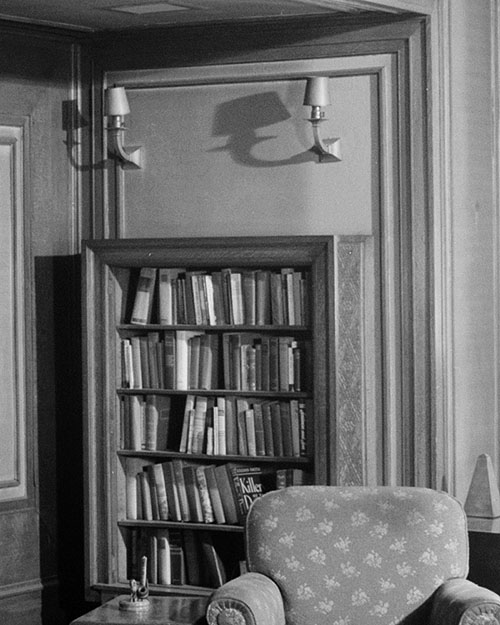 |
| 6D:
Isidore Heller Residence Living Room, Bookcase detail,
Chicago, 1965 (1896 - S.038). The living room brick
fireplace is framed in oak. Built-in bookcases balance each
side of the fireplace area. The bookcase ends are faced with
delicate filigree panels. Photographed by Richard Nickel in
1965. Courtesy of the Library of Congress. |
| |
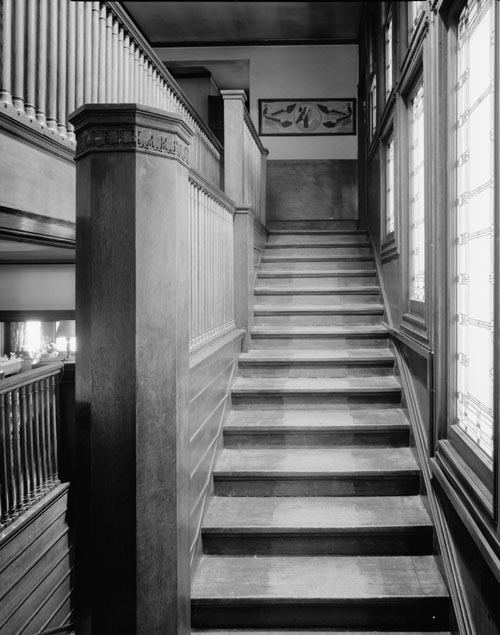 |
| 7: Isidore
Heller Residence Stairway, Chicago, 1965 (1896 - S.038).
Viewed from the East, looking toward the Second level. Oak
woodwork frames the stairway, ceiling and wall spaces.
Although the newel post on the first floor was square, this
newel post on the landing between the first and second
floors is octagonal in shape and matches the upper column in
the reception room, and is decorated at the top with the
Sullivanesque filigree trim. Three upper posts are square
and without the filigree trim. Tightly packed spindles form
screens, partially hiding the stairway from the reception
hall. Eleven art glass windows follow the stairs that lead
to the second floor. Photographed by Richard Nickel in 1965.
Courtesy of the Library of Congress. |
| |
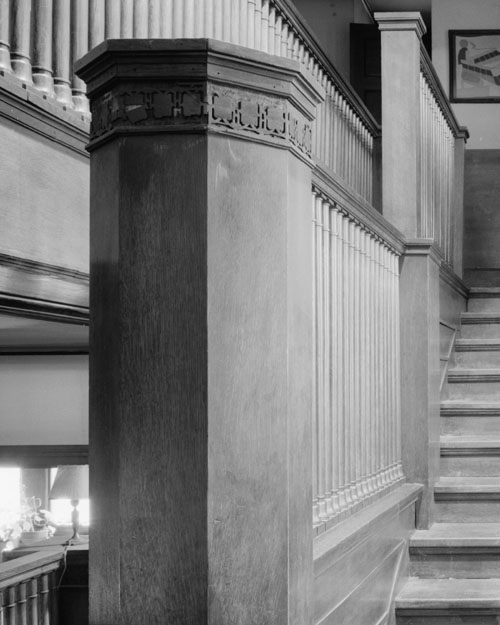 |
| 7A: Isidore
Heller Residence Stairway detail, Chicago, 1965 (1896 -
S.038). Oak woodwork frames the stairway. Although the newel
post on the first floor was square, this newel post on the
landing between the first and second floors is octagonal in
shape and matches the upper column in the reception room,
and is decorated at the top with the Sullivanesque filigree
trim. Three upper posts are square and without the filigree
trim. Tightly packed spindles form screens, partially hiding
the stairway from the reception hall. Photographed by
Richard Nickel in 1965. Courtesy of the Library of Congress. |
| |
 |
| 7B: Isidore
Heller Residence Stairway detail, Chicago, 1965 (1896 -
S.038). Oak woodwork frames the stairway. Although the newel
post on the first floor was square, this newel post on the
landing between the first and second floors is octagonal in
shape and matches the upper column in the reception room,
and is decorated at the top with the Sullivanesque filigree
trim. Upper posts are square and without the filigree trim.
Tightly packed spindles form screens, partially hiding the
stairway from the reception hall. Photographed by Richard
Nickel in 1965. |
| |
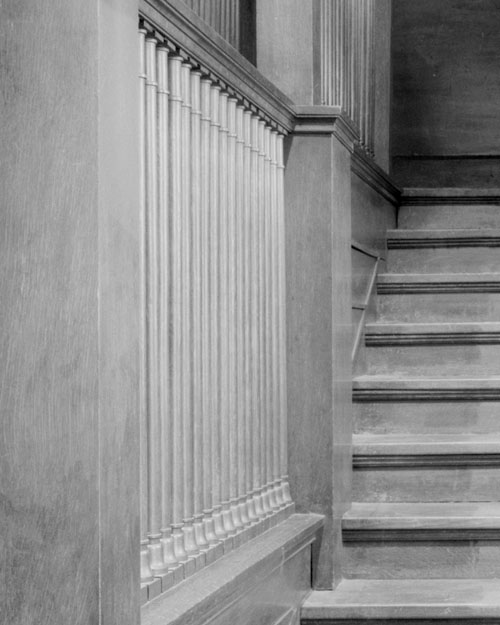 |
| 7C: Isidore
Heller Residence Stairway detail, Chicago, 1965 (1896 -
S.038). Tightly packed spindles form screens, partially
hiding the stairway from the reception hall. Photographed by
Richard Nickel in 1965. Courtesy of the Library of Congress. |
| |
| |
|
|
|
|
Text by Douglas M. Steiner, Copyright
2014 |
|
|
|
|
|
|
|
|
|
|



